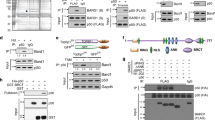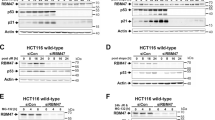Abstract
The BRCA1-associated RING domain protein BARD1 acts with BRCA1 in double-strand break repair and ubiquitination. BARD1 plays a role as mediator of apoptosis by binding to and stabilizing p53 and BARD1-repressed cells are resistant to apoptosis. We therefore investigated the mechanism by which BARD1 induces p53 stability and apoptosis. The apoptotic activity of p53 is regulated by phosphorylation. We demonstrate that BARD1 binds to unphosphorylated and serine-15 phosphorylated forms of p53 in several cell types and that the region required for binding comprises the region sufficient for apoptosis induction. In addition, BARD1 binds to Ku-70, the regulatory subunit of DNA-PK, suggesting that the mechanism of p53-induced apoptosis requires BARD1 for the phosphorylation of p53. Upregulation of BARD1 alone is sufficient for stabilization of p53 and phosphorylation on serine-15, as shown in nonmalignant epithelial cells and ovarian cancer cells, NuTu-19, which are defective in apoptosis induction and express aberrant splice variants of BARD1. Stabilization and phosphorylation of p53 in NuTu-19 cells, as well as apoptosis, can be induced by the exogenous expression of wild-type BARD1, suggesting that BARD1, by binding to the kinase and its substrate, catalyses p53 phosphorylation.
This is a preview of subscription content, access via your institution
Access options
Subscribe to this journal
Receive 50 print issues and online access
$259.00 per year
only $5.18 per issue
Buy this article
- Purchase on Springer Link
- Instant access to full article PDF
Prices may be subject to local taxes which are calculated during checkout






Similar content being viewed by others
References
Baer R and Ludwig T . (2002). Curr. Opin. Genet. Dev., 12, 86–91.
Bork P, Hofmann K, Bucher P, Neuwald AF, Altschul SF and Koonin EV . (1997). FASEB J., 11, 68–76.
Brown KD, Lataxes TA, Shangary S, Mannino JL, Giardina JF, Chen J and Baskaran R . (2000). J. Biol. Chem.., 275, 6651–6656.
Callebaut I and Mornon JP . (1997). FEBS Lett., 400, 25–30.
Chehab NH, Malikzay A, Stavridi ES and Halazonetis TD . (1999). Proc. Natl. Acad. Sci. USA, 96, 13777–13782.
Dull T, Zufferey R, Kelly M, Mandel RJ, Nguyen M, Trono D and Naldini L . (1998). J. Virol., 72, 8463–8471.
Fabbro M, Kienan S, Hobson K, Deans AJ, Powell SN, McArthur GA and Khanna KK . (2004). J. Biol. Chem., 279, 31251–31258.
Fathalla MF . (1972). Obstet Gynecol. Surv., 27, 751–768.
Feki A, Jefford CE, Durand P, Harb J, Lukas H, Krause K-H and Irminger-Finger I . (2004). Biol. Reprod., 71, 1614–1624.
Gautier F, Irminger-Finger I, Gregoire M, Meflah K and Harb J . (2000). Cancer Res., 60, 6895–6900.
Ghimenti C, Sensi E, Presciuttini S, Brunetti IM, Conte P, Bevilacqua G and Caligo MA . (2002). Genes Chromosomes Cancer, 33, 235–242.
Hao M, Lowy AM, Kapoor M, Deffie A, Liu G and Lozano G . (1996). J. Biol. Chem., 271, 29380–29385.
Hashizume R, Fukuda M, Maeda I, Nishikawa H, Oyake D, Yabuki Y, Ogata H and Ohta T . (2001). J. Biol. Chem., 276, 14537–14540.
Hirao A, Kong YY, Matsuoka S, Wakeham A, Ruland J, Yoshida H, Liu D, Elledge SJ and Mak TW . (2000). Science, 287, 1824–1827.
Honda R, Tanaka H and Yasuda H . (1997). FEBS Lett., 420, 25–27.
Honda T, Kagawa S, Spurgers KB, Gjertsen BT, Roth JA, Fang B, Lowe SL, Norris JS, Meyn RE and McDonnell TJ . (2002). Cancer Biol. Ther., 1, 163–167.
Iyengar P, Combs TP, Shah SJ, Gouon-Evans V, Pollard JW, Albanese C, Flanagan L, Tenniswood MP, Guha C, Lisanti MP, Pestell RG and Scherer PE . (2003). Oncogene, 22, 6408–6423.
Irminger-Finger I and Leung WC . (2002). Int. J. Biochem. Cell Biol., 34, 582–587.
Irminger-Finger I, Leung WC, Li J, Dubois-Dauphin M, Harb J, Feki A, Jefford CE, Soriano JV, Jaconi M, Montesano R and Krause KH . (2001). Mol. Cell, 8, 1255–1266.
Irminger-Finger I, Soriano JV, Vaudan G, Montesano R and Sappino AP . (1998). J. Cell. Biol., 143, 1329–1339.
Ishitobi M, Miyoshi Y, Hasegawa S, Egawa C, Tamaki Y, Monden M and Noguchi S . (2003). Cancer Lett., 200, 1–7.
Jack MT, Woo RA, Motoyama N, Takai H and Lee PW . (2004). J. Biol. Chem., 279, 15269–15273.
Jefford CE, Feki A, Harb J, Krause KH and Irminger-Finger I . (2004). Oncogene, 23, 3509–3520.
Jin Y, Xu XL, Yang MC, Wei F, Ayi TC, Bowcock AM and Baer R . (1997). Proc. Natl. Acad. Sci. USA, 94, 12075–12080.
Joukov V, Chen J, Fox EA, Green JB and Livingston DM . (2001). Proc. Natl. Acad. Sci. USA, 98, 12078–12083.
Karppinen SM, Heikkinen K, Rapakko K and Winqvist R . (2004). J. Med. Genet, 41, e114.
Knippschild U, Milne DM, Campbell LE, DeMaggio AJ, Christenson E, Hoekstra MF and Meek DW . (1997). Oncogene, 15, 1727–1736.
Kohn KW . (1999). Mol. Biol. Cell, 10, 2703–2734.
Lakin ND and Jackson SP . (1999). Oncogene, 18, 7644–7655.
Levine AJ . (1997). Cell, 88, 323–331.
Lohrum M and Scheidtmann KH . (1996). Oncogene, 13, 2527–2539.
Lu H, Fisher RP, Bailey P and Levine AJ . (1997). Mol. Cell. Biol., 17, 5923–5934.
Ludwig T, Fisher P, Ganesan S and Efstratiadis A . (2001). Genes Dev., 15, 1188–1193.
Manke IA, Lowery DM, Nguyen A and Yaffe MB . (2003). Science, 302, 636–639.
McCarthy EE, Celebi JT, Baer R and Ludwig T . (2003). Mol. Cell. Biol., 23, 5056–5063.
Meek DW . (1994). Semin. Cancer Biol., 5, 203–210.
Milczarek GJ, Martinez J and Bowden GT . (1997). Life Sci., 60, 1–11.
Oda K, Arakawa H, Tanaka T, Matsuda K, Tanikawa C, Mori T, Nishimori H, Tamai K, Tokino T, Nakamura Y and Taya Y . (2000). Cell, 102, 849–862.
Pomeroy SL, Tamayo P, Gaasenbeek M, Sturla LM, Angelo M, McLaughlin ME, Kim JY, Goumnerova LC, Black PM, Lau C, Allen JC, Zagzag D, Olson JM, Curran T, Wetmore C, Biegel JA, Poggio T, Mukherjee S, Rifkin R, Califano A, Stolovitzky G, Louis DN, Mesirov JP, Lander ES and Golub TR . (2002). Nature, 415, 436–442.
Rodriguez M, Yu X, Chen J and Songyang Z . (2003). J. Biol. Chem., 278, 52914–52918.
Rose GS, Tocco LM, Granger GA, DiSaia PJ, Hamilton TC, Santin AD and Hiserodt JC . (1996). Am. J. Obstet. Gynecol., 175, 593–599.
Schafer R, Tchernitsa OI, Zuber J and Sers C . (2003). Adv. Enzyme Regul., 43, 379–391.
Scully R, Chen J, Ochs RL, Keegan K, Hoekstra M, Feunteun J and Livingston DM . (1997). Cell, 90, 425–435.
Shangary S, Brown KD, Adamson AW, Edmonson S, Ng B, Pandita TK, Yalowich J, Taccioli GE and Baskaran R . (2000). J. Biol. Chem., 275, 30163–30168.
Shieh SY, Ikeda M, Taya Y and Prives C . (1997). Cell, 91, 325–334.
Shieh SY, Taya Y and Prives C . (1999). EMBO J., 18, 1815–1823.
Stark JM, Pierce AJ, Oh J, Pastink A and Jasin M . (2004). Mol. Cell. Biol., 24 (21), 9305–9316.
Thai TH, Du F, Tsan JT, Jin Y, Phung A, Spillman MA, Massa HF, Muller CY, Ashfaq R, Mathis JM, Miller DS, Trask BJ, Baer R and Bowcock AM . (1998). Hum. Mol. Genet., 7, 195–202.
Tibbetts RS, Brumbaugh KM, Williams JM, Sarkaria JN, Cliby WA, Shieh SY, Taya Y, Prives C and Abraham RT . (1999). Genes Dev., 13, 152–157.
Williams RS, Green R and Glover JN . (2001). Nat. Struct. Biol., 8, 838–842.
Woo RA, Jack MT, Xu Y, Burma S, Chen DJ and Lee PW . (2002). EMBO J., 21, 3000–3008.
Woo RA, McLure KG, Lees-Miller SP, Rancourt DE and Lee PW . (1998). Nature, 394, 700–704.
Wu LC, Wang ZW, Tsan JT, Spillman MA, Phung A, Xu XL, Yang MC, Hwang LY, Bowcock AM and Baer R . (1996). Nat. Genet., 14, 430–440.
Yu X, Chini CC, He M, Mer G and Chen J . (2003). Science, 302, 639–642.
Zacchi P, Gostissa M, Uchida T, Salvagno C, Avolio F, Volinia S, Ronai Z, Blandino G, Schneider C and Del Sal G . (2002). Nature, 419, 853–857.
Zuco V, Supino R, De Cesare M, Carenini N, Perego P, Gatti L, Pratesi G, Pisano C, Martinelli R, Bucci F, Zanier R, Carminati P and Zunino F . (2003). Biochem. Pharmacol., 65, 1281–1294.
Zufferey R, Nagy D, Mandel RJ, Naldini L and Trono D . (1997). Nat. Biotechnol., 15, 871–875.
Acknowledgements
We are grateful to MH Sow, A Caillon and C Genet for technical help. We are specifically indebted to Dr A Major for supply and sharing of expertise in the NuTu-19 cell line. We are grateful to G Del Sal for his generous gift of expression plasmids of the p53 mutants and T McDonnell for PC3 cell line. This work was supported by grant 3100-068222 from the Swiss National Science Foundation to IIF and KHK.
Author information
Authors and Affiliations
Rights and permissions
About this article
Cite this article
Feki, A., Jefford, C., Berardi, P. et al. BARD1 induces apoptosis by catalysing phosphorylation of p53 by DNA-damage response kinase. Oncogene 24, 3726–3736 (2005). https://doi.org/10.1038/sj.onc.1208491
Received:
Revised:
Accepted:
Published:
Issue Date:
DOI: https://doi.org/10.1038/sj.onc.1208491
Keywords
This article is cited by
-
BARD1 mystery: tumor suppressors are cancer susceptibility genes
BMC Cancer (2022)
-
The Ku complex: recent advances and emerging roles outside of non-homologous end-joining
Cellular and Molecular Life Sciences (2021)
-
SRPK1 acetylation modulates alternative splicing to regulate cisplatin resistance in breast cancer cells
Communications Biology (2020)
-
Germline variants in DNA repair genes associated with hereditary breast and ovarian cancer syndrome: analysis of a 21 gene panel in the Brazilian population
BMC Medical Genomics (2020)
-
BARD1 mediates TGF-β signaling in pulmonary fibrosis
Respiratory Research (2015)



